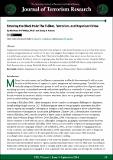Files in this item
Entering the black hole: the Taliban, terrorism, and organised crime
Item metadata
| dc.contributor.author | Phillips, Matthew D. | |
| dc.contributor.author | Kamen, Emily A. | |
| dc.date.accessioned | 2014-10-29T16:37:03Z | |
| dc.date.available | 2014-10-29T16:37:03Z | |
| dc.date.issued | 2014-09-01 | |
| dc.identifier.citation | Phillips, M. D., & Kamen, E. A. (2014). Entering the black hole: the Taliban, terrorism, and organised crime. Journal of Terrorism Research, 5(3), pp. 39-48. | en_US |
| dc.identifier.issn | 2049-7040 | en_US |
| dc.identifier.uri | http://ojs.st-andrews.ac.uk/index.php/jtr/article/view/945 | en_US |
| dc.identifier.uri | https://hdl.handle.net/10023/5612 | |
| dc.description.abstract | Cooperation and imitation among crime and terror groups in recent years has given rise to a crime-terror nexus. A linear conceptualisation of a crime-terror spectrum, suggests that complete convergence of crime and terror in a failed state can give rise to a ‘black hole.’ Theoretical models of the crime-terror nexus, however, do not specify the means by which a crime-terror group enters this black hole state, yet others do not. Using the Taliban movement as a case study, this article presents a theoretical extension of black hole theory, using organisation-level characteristics to merge black hole theory with the crime-terror continuum. | en_US |
| dc.language.iso | en | en_US |
| dc.publisher | Centre for the Study of Terrorism and Political Violence, University of St Andrews | en_US |
| dc.relation.ispartof | Journal of Terrorism Research | en_US |
| dc.rights | This is an open access article published in Journal of Terrorism Research. This work is licensed under a Creative Commons Attribution 3.0 License (http://creativecommons.org/licenses/by/3.0/) | en_US |
| dc.rights.uri | http://creativecommons.org/licenses/by/3.0/ | |
| dc.subject | Taliban | en_US |
| dc.subject | Organized Crime | en_US |
| dc.subject | Terrorism | en_US |
| dc.subject | Crime-Terror Nexus | en_US |
| dc.subject | Narco-Terrorism | en_US |
| dc.subject | Black Holes | en_US |
| dc.subject.lcc | HV6431 | en_US |
| dc.subject.lcsh | Terrorism | en_US |
| dc.title | Entering the black hole: the Taliban, terrorism, and organised crime | en_US |
| dc.type | Journal article | en_US |
| dc.description.version | https://doi.org/Publisher PDF | en_US |
| dc.publicationstatus | Published | en_US |
| dc.status | Peer reviewed | en_US |
| dc.identifier.doi | https://doi.org/http://doi.org/10.15664/jtr.945 | en |
This item appears in the following Collection(s)
Except where otherwise noted within the work, this item's licence for re-use is described as This is an open access article published in Journal of Terrorism Research. This work is licensed under a Creative Commons Attribution 3.0 License (http://creativecommons.org/licenses/by/3.0/)
Items in the St Andrews Research Repository are protected by copyright, with all rights reserved, unless otherwise indicated.


